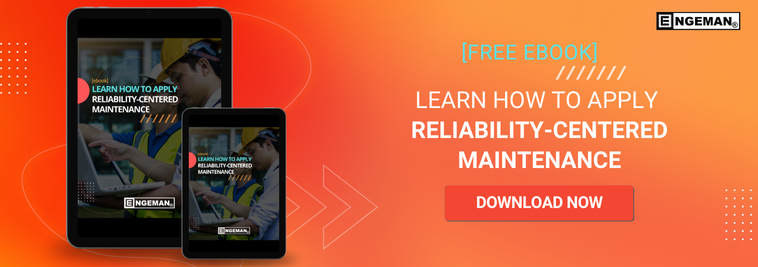Contents
- But, after all, what is Reliability-Centered Maintenance (RCM)?
- Brief History
- What concepts is RCM based on in asset maintenance?
- How does this methodology apply, above all, in practice?
- How is the RCM implemented?
- What are the advantages of implementing RCM in companies?
- How to be sure that the application of the RCM is bringing results?
- Reliability-Centered Maintenance
But, after all, what is Reliability-Centered Maintenance (RCM)?
Reliability-Centered Maintenance is a structured method to establish the best maintenance strategy. This methodology brings together, in a balanced way, the best maintenance techniques.
By guaranteeing the reliability and availability of items considered critical for the production of a company, RCM certainly emerges as an excellent asset management strategy within a company. On the other hand, in the same way, because it is a methodology that involves relatively high costs and because not all equipment is critical in relation to maintenance, it uses other techniques, such as TPM (Total Productive Maintenance), thus, in addition to the RCM, it can be a viable and equally efficient alternative.
Brief History
RCM started over 25 years ago in the airline industry, through the analysis of civil aviation maintenance policies. In the early 1970s, the first RCM concepts were developed and documented in scientific works.
This maintenance method has the paradigm of “preserving the function of the system”. Among the main operational concerns are: analyzing failures; probabilities of recurrences; definition of procedures; prioritization criteria based on economic factors and efficient and safe practices involving cost-effectiveness in combating failures.
What concepts is RCM based on in asset maintenance?
The reliability of an asset is based on the probability that an asset will perform its necessary function in a given period of time.
Probability, in turn, is certainly a statistical concept expressed by:
N favorable cases / N possible cases, such that the value is less than or equal to 1
The value represented by 1 being the indication that the problem will certainly occur and the value represented by 0 indicating the null probability of the event happening. This probability index can be expressed by values between 0 to 10, or as a percentage from 0 to 100%.
How does this methodology apply, above all, in practice?
After the process of implementing Reliability-Centered Maintenance, in the same way, it is time to put it into practice. This starts with seven questions. They are:
- What are the functions and performance standards of the system/equipment in your current context of operation?
- How can the system fail to perform these functions?
- What can cause functional failure?
- What happens when the failure occurs?
- What can be the consequences of the failure?
- What can be done to detect or prevent failure?
- What should be done if a maintenance task is not identified?
When answering these seven questions, it is possible to highlight what each asset being revised accomplishes in its production context.
How is the RCM implemented?
In a general context, likewise, these issues comprise the following steps:
- system definition (borders / interfaces);
- functions and analysis of functional failures;
- failure mode and effects analysis (FMEA);
- decision diagram for selecting maintenance tasks;
- formulation and implementation of the maintenance plan based on the RCM
What are the advantages of implementing RCM in companies?
So, in general, the main goal of implementing Reliability-Centered Maintenance in an organization is to increase the availability of equipment and, consequently, optimize a productivity.
Finally, Reliability-Centered Maintenance generates significant gains in other areas of the company. When extrapolating the analysis of results after the implementation of the methodology, it is possible to notice, in the medium and long term:
- greater reliability;
- greater security;
- improvement in product quality;
- absence of damage to the environment;
- greater effective cost (when it is ensured, through correct maintenance practices, that the capital invested has the best return).
How to be sure that the application of the RCM is bringing results?
Any and all management methodology, which aims to improve processes and increase productivity within a company, as is the case with RCM, needs to be managed and monitored.
Therefore, within this context, for the good management of Reliability-Centered Maintenance, it is essential to trace and measure performance indicators, due to the fact that the technique is bringing the expected advantages.
Below are some of the most used indicators to measure the efficiency of an RCM plan within a company:
- MTBF – Mean Time Between Failures;
- MTTR – Mean Time to Repair,
- Horizontal reliability;
- Charts/reports showing equipment diagnostics.
All of these indicators, consequently, the reliability of the processes increase, but it is necessary, as a result, in the same way, that they be collected and measured accurately. And this is where automation software works in the context of Reliability-Centered Maintenance.
Reliability-Centered Maintenance
Especially when it comes to monitoring the asset and responding quickly to its failure trends.
Number of items produced, vibration anomalies, first of all, pressures or temperatures are some examples of indicators that can be measured.
Engeman® is a software specialized in PCM control (Planning and Control of Maintenance) and manages the entire RCM process, with more than 250 standard reports, several KPIs and tools for failure analysis and services (check here some of the available reports in the software).
Do you like this content and think it was useful for you? Then follow Engeman’s blog and don’t miss any more content!




